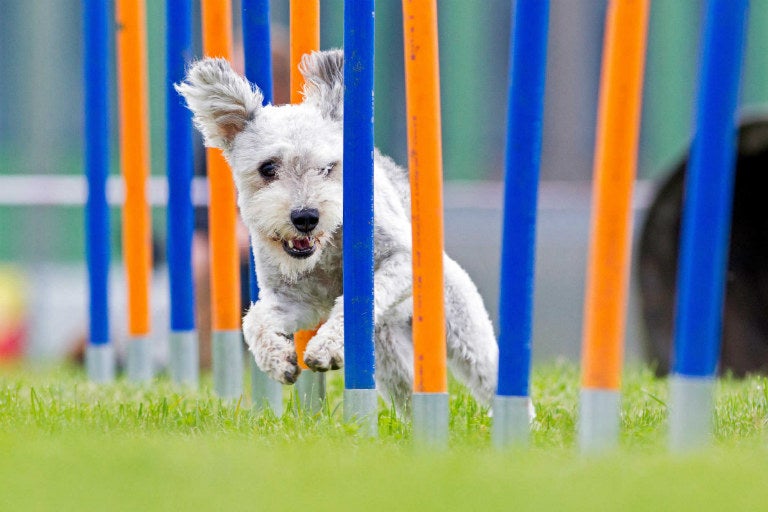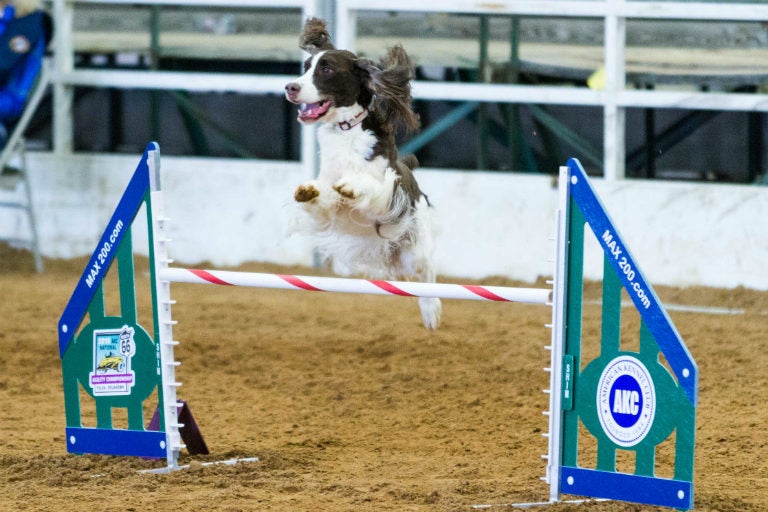Agility is one of the fastest-growing dog sports in the country—and for good reason. It’s incredible exercise for both you and your dog, and it forges an even deeper relationship between you. Plus, it’s exhilarating to watch as your dog nimbly and quickly crawls through tunnels, weaves around poles, and leaps through tires! Here’s everything you need to know to get started in Agility:
Understand the Basics
Dog agility is a sport where you direct your dog through a pre-set obstacle course within a certain time limit. Courses typically have between 14-20 obstacles, which can include tunnels, weave poles, tire jumps, seesaws, and pause tables where the dog must stop for a set amount of time. At each trial you and your dog will race around the unique courses designed for that day. All of this is done with your dog relying solely on the cues and body language you use to direct them on course.
All breeds, including mixed breeds, can participate in Agility – from the smallest to the largest of dogs.
If you’ve never seen Agility in person, we highly recommend you attend a competition (or “trial”) to see it firsthand.
Make Sure the Sport of Agility Is Right for Your Dog – and You
Assess your dog’s temperament to be sure he’s right for Agility: Is he highly energetic? Does he enjoy running and responding to instruction? Does he get along well with other dogs? If so, agility could be a great fit.
But training doesn’t only involve your dog. You are critical to the process. You don’t need to be a world class sprinter to do agility with your dog. Through training and the development of good communication you and your dog can become part of the sport of Agility.
Take a Class
As with any sport, we recommend you start by taking a class at an AKC club near you. Beginner courses introduce you and your dog to obstacles, and provide the basics of how to compete should you decide to go that route. Most classes meet once a week for an hour or so.
Practice at Home Using Your Own Equipment
Just because you’ve signed up for a class, don’t think the learning stops there. Practicing at home is just as important! To do so, you’ll want to set up your own obstacles. First-timers often start out with tunnels, which can be collapsed when not in use, and tunnel holders to keep them in place. Weave poles—or a few evenly spaced upright poles that your dog can run through—are another popular at-home obstacle. At-home training equipment can be purchased online or you can build it yourself with PVC pipes. If you go the DIY route, be sure to follow the specifications in the Regulations for Agility.
Count on spending at least 15-20 minutes a day practicing the moves you learned in class. Consider using incentives such as treats or toys to help entice your dog through the course. Take your time, especially in the beginning while you’re both getting used to the sport.
Consider Competing!
Agility can be so thrilling that you might find yourself wanting to go to the next level and actually competing. A great starting place to test your dog’s skills is at an AKC Agility Course Test (ACT).
Once you are ready to compete, you will find that there are three types of Agility trials (“competitions”):
- All-breed agility trials for more than 150 breeds and varieties of dogs recognized by the AKC. This is the most common type of trial offered.
- Specialty trials for dogs of a specific breed or varieties of one breed.
- Group trials for dogs of a specific breed group such as herding, working, and so on.
Find an Agility event near you.
To be eligible to compete in Agility, your dog must be:
- 15 months of age or older.
- Registered with the American Kennel Club or listed with the AKC Indefinite Listing Privilege (ILP) program, which allows unregistered dogs of registerable breeds to compete in AKC Performance and Companion Events.Mixed breed dogs can be registered through the Canine Partners program to be able to compete.
- Spayed or neutered dogs are eligible to compete.
- In sound health and up-to-date on vaccinations.




